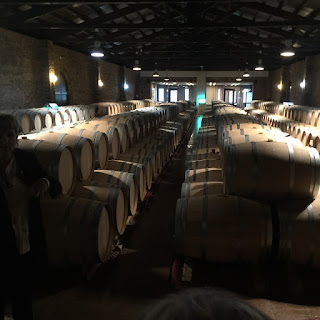In terms of the lead enologists, every one that I spoke to had studied enology in either Bordeaux or Burgundy and had interned at a French vineyard and continued to spend harvests, when possible, in the Southern Hemisphere.
In this post I describe the methods employed by these practitioners to develop the wines of North Greece (I have discussed the physical environment, variety and rootstock choices, and vine training and vineyard management practices in previous posts.).
One of the most important decisions confronting a winemaker is deciding when to pick the grapes. The "optimal"harvest time is dependent on the winemaker's style and intent. In North Greece, most winemakers use a mix of objective and subjective factors to arrive at that determination. Alpha Estate, for example, bases optimal picking time on sugar levels (210 g/L for whites, 235 g/L for reds), titratable acidity (6.5 g/L for whites, 5.8 g/L for reds), and subjective factors such as color, texture, aroma, and flavor. According to Angelos Iatridis, Alpha Estate's winemaker, all of the objective and subjective parameters are taken into consideration in combination with lab analysis and taste based on the winemaker's experience.
All of the wineries surveyed harvested manually and transported the grapes back to the winery in small (15 - 20 kg) crates. In cases where there is some remove between vineyard and winery, the grapes are transported between the two in refrigerated trucks.
A first level of selection is implemented in the vineyards in order to ensure that only the best grapes get to the winery. Kir-Yianni is exemplary, harvesting up to three times per block depending on grape maturity. Such a practice allows the winery to counter uneven ripening in the vineyard and advances the goal of fully ripe fruit to the cellar door.
Grapes are consistently destemmed prior to crushing with, in many cases, hand-sorting prior to de-stemming. In the case of Kir-Yianni, the grapes are subjected to a second sorting table prior to crush. Alpha Estate does no additional sorting beyond that done in the vineyard. Ktima Pavlidis moves the fruit to the tank via elevator or by pumping it up to the tank. This practice is a little at odds with today's perceived wisdom of gravity-flow wine production.
All of the wineries "cold soak" the fruit prior to fermentation with temperatures ranging between 8℃ and 10℃ for whites and 8℃ - 13℃ for reds. Duration ranges between 6 and 18 hours for whites and 2 to 7 days for reds.
Alpha Estate is the only domaine acknowledging must adjustment. According to Angelos, he will adjust the acidity in Xinomavro must in cool years. Amyndeon is a naturally cool region and so has high acid retention. Xinomavro is a variety with high natural acidity. In cooler years that combination will produce wines with very high acid levels; levels that would sorely tax the softening capacity of malolactic bacteria.
Selected yeasts are used for most alcoholic fermentation with some limited use of indigenous yeasts at Ktimas Gerovassiliou and Pavlidis. The fermentation vehicle of choice is stainless steel tanks with half of the respondents doing some additional fermentation in oak. Fermentation temperatures range between 16℃ and 18℃ for whites (14℃ at Alpha Estate) and 20 - 27℃ for reds.
 |
| Courtesy Alpha Estate |
 |
| Press at Ktima Pavlidis |
Malolactic fermentation is widely employed for reds with natural ML bacteria as the initiator. The process is either conducted fully in tank or is initiated in the tank and completed in oak barrels. Alpha Estate utilizes selected bacteria for its malolactic fermentation.
Most aging is done in 225L Frenck oak barriques of between one and three years of age. Tsantali utilizes 300L French oak barrels for its aging while Kir-Yianni employs 228L and 500L barrels in addition to the barriques.
 |
| Barrel Room at Domaine Biblio Chora |
©Wine -- Mise en abyme
Having been on a similar trip to yours, I very much agree with your first sentence. There was also a lot of enterprise shown: the saving of the Malgousia variety, investment in Rapsani and Metsovo, the introduction of Cab Sauv into high altitude vineyards in Metsovo, and the current pursuit of quality at Alpha. But we must also remember that these are some of the best producers of the region, rather than typical examples.
ReplyDeleteSteve, thank you for that observation. Obviously I can only report on what I have been exposed to but your comments have spurred me on to explore what that "other side" looks like and to compare and contrast the two.
Delete